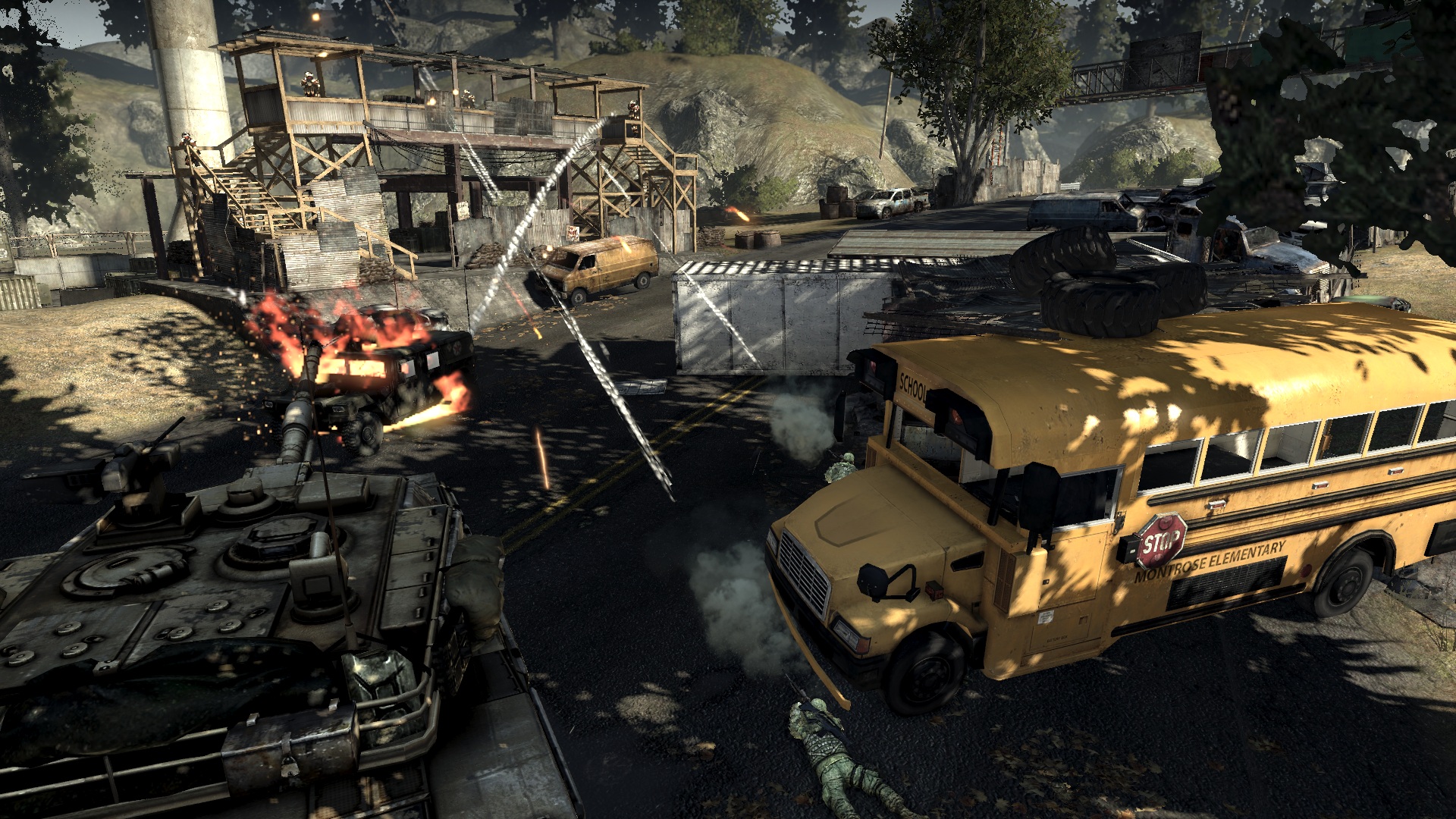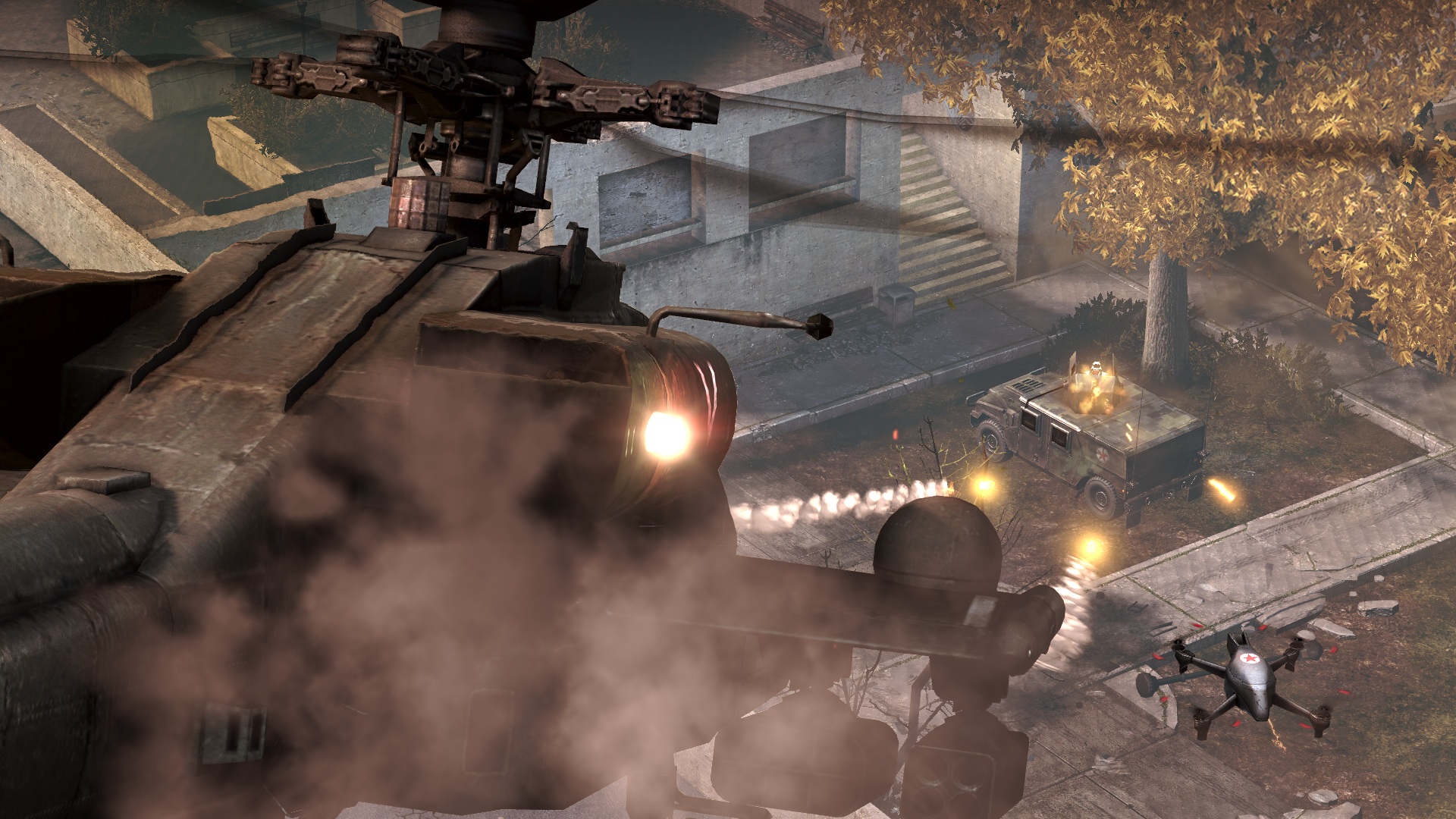
The battle is raging in furious chaos. Soldiers are dropping left and right. My team and I are trying to hold on to the objective points to win the battle. Our enemies had fought back our previous advance and now we find ourselves back in our original stations trying to put a halt to this counterattack. I take as many North Korean forces with me as I can, but the number is too many. I fall in battle.
But when I check my respawn options, I have contributed to the mission so successfully that I can bring in a tank with me. I spawn as the vehicular behemoth’s driver. One of my fellow American soldiers spots me and jumps in the turret. Together we begin blasting away the Koreans left and right. We have tipped the scales of battle, but then the enemy forces pull out all the stops and decide to reveal their trump card.
One of the enemies pilots an Apache helicopter into the battlefield, raining missiles upon our comrades and clearing the objectives for his teammates. Spotting my gunner and I, he turns his attention to us. He is too high for my cannon to reach, so I rely upon my teammate to shell him while I try to maneuver through the rockets and mow down any Korean infantry looking to disable us. After a fury of explosions that send bodies flying for several minutes, the Apache pilot makes the mistake of lowering its altitude into my firing range. My teammate unloads rounds as I bring an erupting shell upon the chopper, finally bringing the flying terror down.
With our combined killing spree drawing the attention of the fallen enemy, our allies are able to hold out and bring us to victory. We have won this day, or at least this match. This is just one example of the excitement, chaos, and downright fun that can be found in Homefront‘s multiplayer.
The multiplayer system in Homefront combines the best of corridor shooters like Call of Duty and the best of more open modern war shooters like Battlefield into a wonderfully meshed package. The game has maps that are both small enough for close-combat, infantry-only matches and large enough for a more open, vehicle- and strategy-filled contests. You can fight through houses and in suburban streets, or at the intersection of two highways. Whatever style you prefer, whether it’s infantry, vehicular, or a balanced combination of the two, Homefront will cater to you.
The game will have several gametypes, but the only two that were available in the demo were Team Deathmatch and Homefront‘s own Ground Control. Team Deathmatch works as you would assume: two teams compete against each other to reach a maximum number of kills. Ground Control is similar to Call of Duty’s Domination, but with a very appealing twist. Instead of just having to compete over one set of three objectives, Ground Control has three. Each team will compete for the first set in the middle and after one side has held those objectives for a certain amount of time, they will win the round and the game will shift over to a second set. That set will be behind the losing team’s original spawn, thus forcing the losing team to retreat while the winning team pushes forward. If the losing team ties things up, they will push the fight back to the middle set. The first team to win two rounds takes the game. It’s really quite a beautiful change to the game’s traditional iteration as it gives players a sense of being deep in a battle that has the kind of ebb and flow a conflict in real life would.
In most multiplayer games, teammates will notice when a player is single-handedly destroying you and point him out via in-game communication. Homefront has developed a system that will do that job for you and give you bonus points for taking down your team’s nemesis. The system is called Battle Commander and it is an optional addition to each match.

What Battle Commander does is keep track of each player’s killstreaks. The bigger a killstreak you get, the more players on the enemy team Battle Commander will alert of your dominance. Those players will then be offered extra Battle Points, another element of Homefront‘s multiplayer, to hunt you down and kill you. For a two-kill streak, two players are alerted. For four kills, four enemies. The higher the streak, the higher the BP bounty on your head. Each streak is represented to you by stars and to the enemy by skulls. The maximum number of stars/skulls a player can earn is five. At five stars/skulls, the entire enemy team is alerted to your presence and tasked to kill you.
What this all does is create a minigame within the real game, and it’s a lot of fun. If you’re given the bounty, not only do you get the sweet satisfaction of taking it to the guy who’s kicking your ass, but you’re also racing and competing with your teammates to kill him first and get the BP reward. If you’re the one doing the killing, it gives this nervous sense of paranoia and a feeling of you vs. the world. It can be nerve-wracking, exciting, and ego-building all at the same time.
Battle Commander does however have the potential to ruin games as well. The desire to get a high killing streak could lead players to heavily spawn-camp opposing players, especially in objective-based games where it is easier to get behind enemy spawning lines. But the system does take notice when players work together. Both pilots/drivers and gunners of vehicles will share all kills the duo gather while in the war machines at the same time.
The second big component of Homefront‘s multiplayer is the Battle Points system. Battle Points act as a way to make strategic decisions based upon winning an individual match or furthering a player’s level advancement and unlocks. Players will earn Battle Points in each game for kills, assists, taking over and defending objective points, scanning enemies with one of the game’s many drones, and through other means. These points will add up over the course of the game and can be spent in multiple ways. Players can use the points to get items in their purchase slots, accessed by pressing up and down on the D-Pad and customizable in the multiplayer menus, that include flak jackets, RPGs, remote-controlled drones, and UAV sweeps. The cost of those items will vary depending on how much potential each one has of tipping the balance of a match.
The second way is to save up and buy a vehicle, which will take a respawn to do. The vehicles will take a lot of damage and can wreak havoc on the enemy, but they cost anywhere from two to 10 times as much as the items in your purchase slots. The third way you can use your Battle Points is not at all. Holding on to your accumulated Battle Points will give you extra experience points after the match, which will further your leveling and earn you unlockable items and perks quicker. It’s a very interesting risk/reward system that will make players think about what’s more important to them: destroying the enemy team and helping to bring your team to victory, or selfishly hoarding it for you own personal gain.
The game’s leveling system is very similar to that of other military FPS games, but also has some unique twists. Instead of having two perks that are given based on killstreaks, each player has two slots for items that can be purchased in-game with BP. Since BP is earned in multiple ways and not just kills, this can help take the focus off of every player trying to get as many kills as possible, which can often cause a complete lack of teamwork in other games. The player is also allowed to chose one primary weapon from assault rifles and SMGs to sniper rifles and shotguns. Each weapon is allowed to have one attachment, and each player only has access to one special explosive (C4, EMP grenade) in addition to regular grenades. Abilities are also present, but instead of choosing three like in Call of Duty, players are given a certain number of points (the demo allowed six) to pick and choose abilities that cost between one, two, or three points. These abilities ranged from faster reload and better firing from the hip to being undetectable by UAVs and more. As you level, players will unlock more weapons, special explosives, attachments, purchasable items, and abilities. It all adds up to what feels like a much more sensible and balanced system than is offered in other first-person shooters.
The game still has a few glitches unfortunately. Sometimes I found myself shooting at the back of an enemy that was sticking out behind a tree, only to see my rounds do nothing and register as hitting said tree. Twice I lay prone inside a building and spawned a drone that malfunctioned. The first time it was unable to attack or look around, while the second time it got stuck in the floor. I also at one point parachuted out of a scout helicopter and upon landing, found my camera halfway inside of my character model. This completely threw off my aiming and got quite annoying. Luckily, THQ announced that this was not the final build of the game, so hopefully they will be able to fix these glitches and polish what is already a great multiplayer experience.
If you’re tired of playing the same old corridor shooter with an unbalanced leveling system and emphasis on killstreaks or just looking for a change from the current formula, Homefront is shaping up to be that game. It has maps and gametypes set to appeal to both small-map infantry corridor players and large-map vehicle lovers. It has an innovative way of leveling and obtaining special weapons and vehicles during matches that makes players weigh the risks and rewards of their decisions. It also creates minigames within the title’s own main gametypes. The combat is intense, brutal, and immensely satisfying. Some bugs and the possibility of heavy spawn killing could hurt it, but the game has yet to receive its final layer of polish, so these issues can be fixed by release. If you’re looking for a complete, well-rounded multiplayer experience, make sure you keep Homefront on your radar.

















